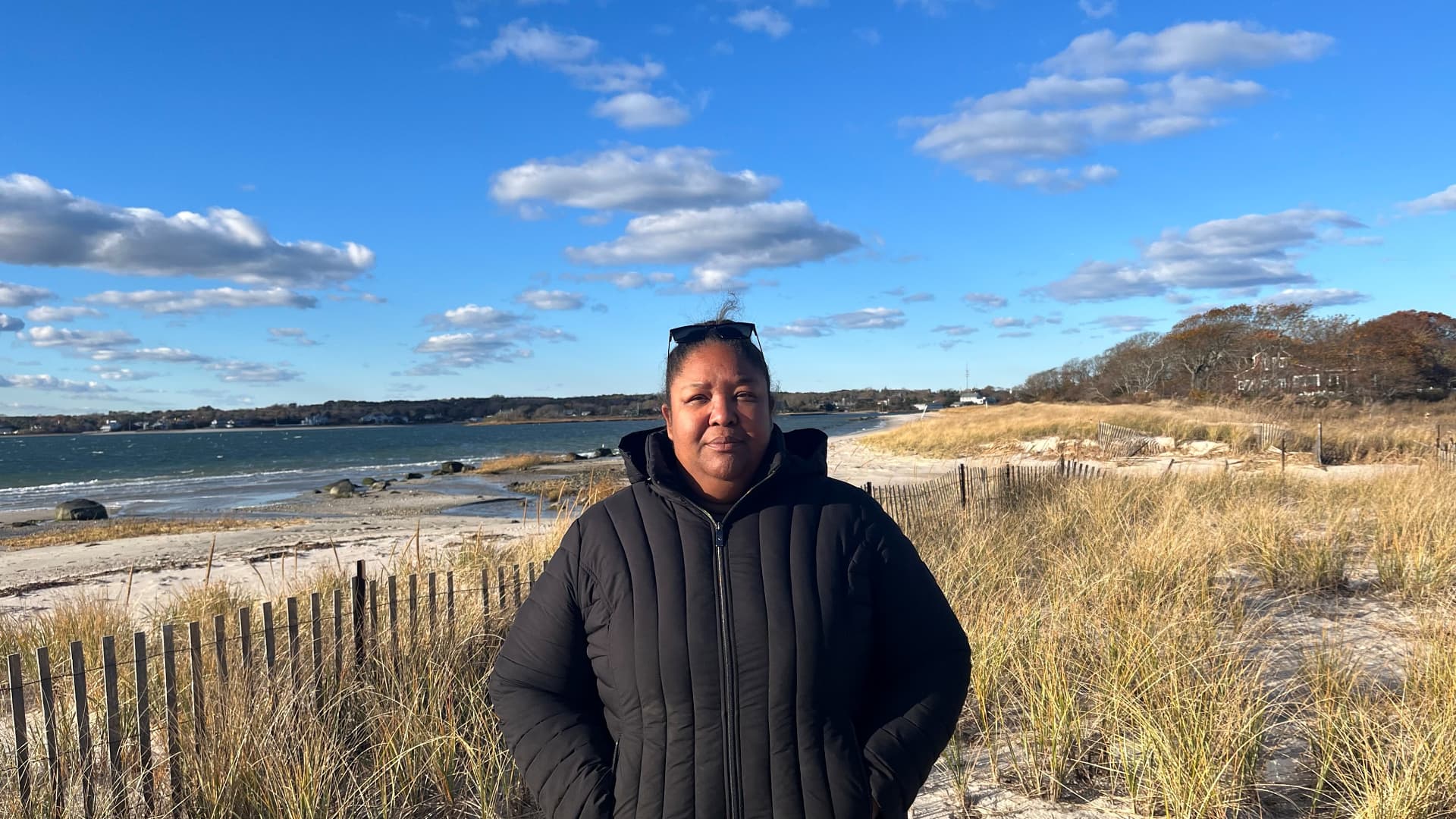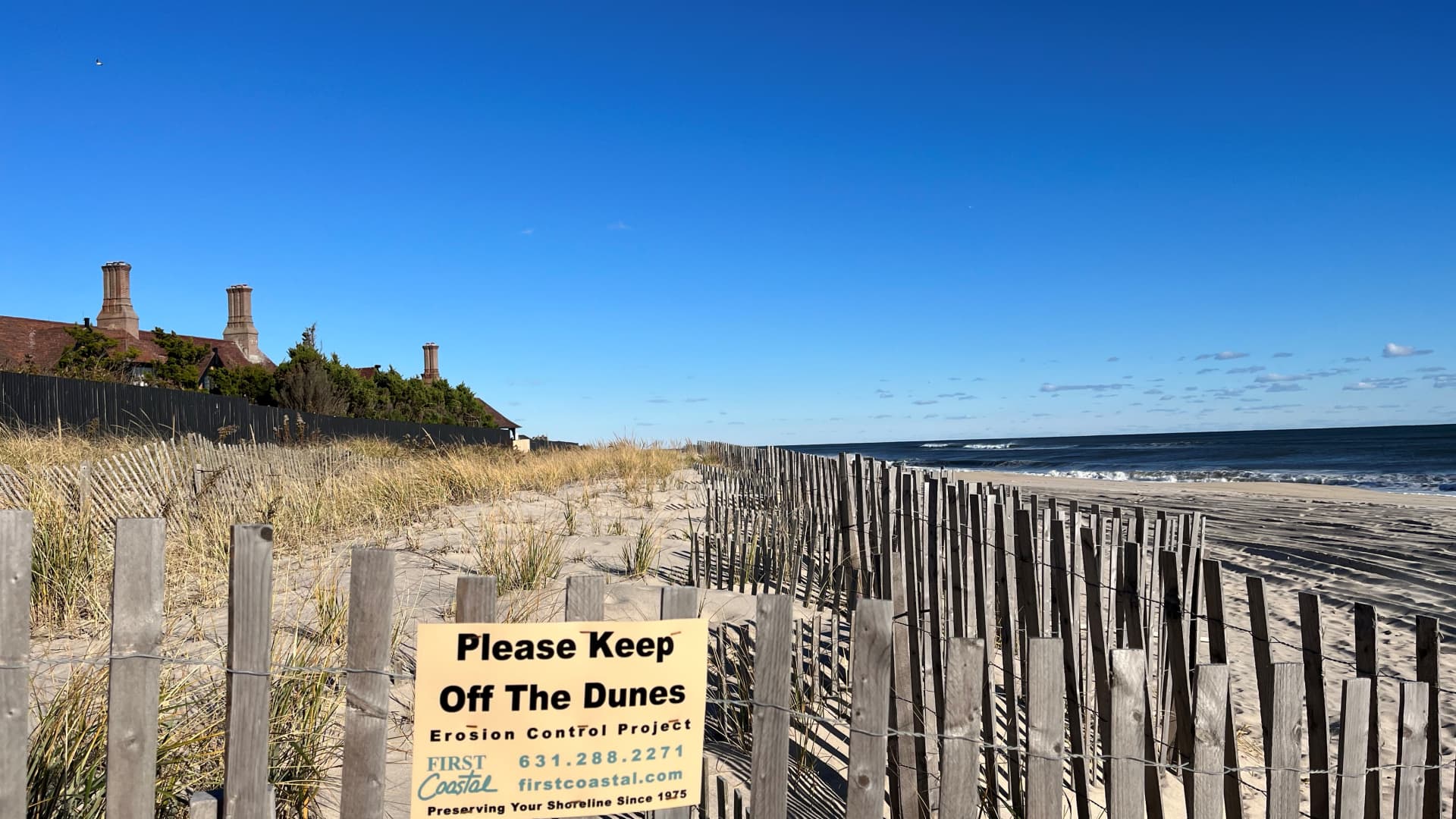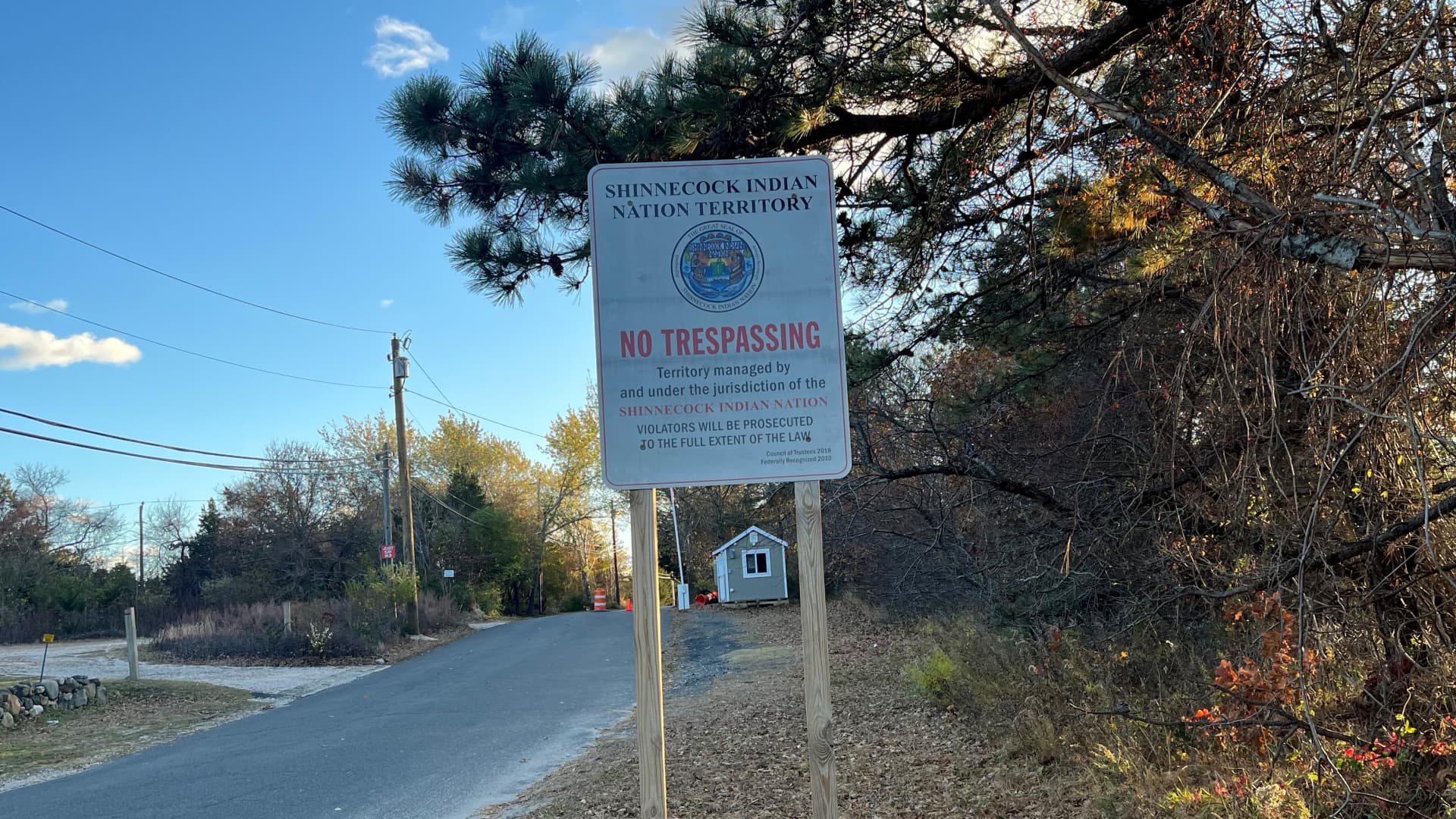
- The Shinnecock Indian Nation is fighting to save what's left of its land as climate change prompts sea levels to rise and eat away the shoreline in Long Island, New York.
- European settlers, and later the U.S. government, for centuries have forcefully relocated Indigenous tribes onto marginal lands more vulnerable to climate hazards.
- "This is the only place we have to remain. This is our homeland," said Shavonne Smith, director of the tribe's environmental department.
SOUTHAMPTON, N.Y. — The Shinnecock Indian Nation once had seasonal villages that stretched across the eastern end of Long Island. But after centuries of land loss and forced relocation, more than 600 tribe members now live on a shrinking 1.5 square mile peninsula.
The Shinnecock, whose name means the "people of the stony shore," are fighting to save what's left of their land as climate change prompts sea levels to rise and eat away the shoreline. The tribe has used nature to restore the land, from building oyster reefs to lining up boulders on the shoreline to blunt the energy of the waves of Shinnecock Bay.
"This is the only place we have to remain. This is our homeland," said Shavonne Smith, director of the tribe's environmental department, walking near a scared burial ground that's at risk of flooding. "And this is all that's left of it."
Get Tri-state area news delivered to your inbox.> Sign up for NBC New York's News Headlines newsletter.
Since the mid-19th century, the Shinnecock have had a reservation of about 800 acres — a fraction of their traditional lands. Sea level rise on the Shinnecock lands is projected to reach between 2.1 to 4.4 feet by the end of the century. Nearly half of the peninsula is forecast to be inundated by floods if a 100-year storm occurs in 2050, when sea levels are projected to be 1.5 feet higher than today, according to the tribe's climate adaptation report.
"The water levels are getting higher. I've seen it," said Shinnecock aquaculture manager Mila McKey, who grows oysters and restores clam populations in a creek on the tribe's land. "Everyone's affected by it."
Across the shoreline from the reservation, rising sea levels also plague the affluent beachfront communities of Southampton, where some homeowners have resorted to building sea walls that temporarily hold back water while causing the beach to wash away. The federal government is set to spend billions of dollars shoring up the coastline and protecting real estate in areas like Fire Island, Southampton and East Hampton.
Money Report
The Shinnecock's battle to save their land from rising seas and erosion reflects a broader problem of racial inequity and environmental justice in the U.S., where historically oppressed and disenfranchised indigenous groups have been left more exposed to the effects of climate change. As global temperatures rise and climate disasters grow more frequent and intense, marginalized groups are under greater pressure to fight and adapt to climate change.
For centuries, European settlers, and later the U.S. government, have forcefully relocated Indigenous tribes onto marginal lands more vulnerable to climate hazards. Research published in the journal Science in October found that tribal nations have lost 99% of their historic territory. The land they were left with is often more prone to disasters like heat waves, wildfires and drought, as well having diminished economic value due to lower mineral resource potential.

Hurricane Sandy in 2012 was particularly destructive for the reservation. It washed away bluffs along the shores in the Great Peconic Bay area, inundated the cemetery and ripped roofs off tribal buildings and residential homes. Research shows that more than $8 billion of the total $60 billion in damage from Sandy was attributable to rising sea levels.
Mass relocation due to climate change would be devastating for the Shinnecock, who have inhabited this slice of land for generations. Unlike many of the beachfront homeowners in the Hamptons, who could relocate inland, the Shinnecock, along with other Indian reservations across the U.S., have strict boundaries and a cultural connection to the land.
"The Shinnecock have been restricted," said Alison Branco, the coastal director for the Nature Conservancy in New York. "It's one thing to ask people to move inland when they have a town. But when your reservation is already small and shrinking from sea level rise — that's a completely different situation."
A deep connection to disappearing land
The Shinnecock descended from the Pequot and Narragansett Nations of southern New England. In the mid-17th century, European settlers arrived in eastern Long Island and encroached on the tribal lands, bringing infectious diseases that decimated the Shinnecock population.
For generations, the Shinnecock lived in seasonal villages on Long Island, where they moved closer to the water in the spring and summer and moved to woodland areas in the fall and winter. Now, the majority of the reservation resides in a low-lying, south-facing peninsula on Shinnecock Bay that's particularly vulnerable to ocean storm surges and floods. Climate change is also harming the quality of the water by increasing temperatures, salinity and acidification.

Today, one in five people on the reservation live below the poverty line. Life on the reservation marks a sharp contrast to surrounding communities, home to the Hamptons’ elite, many of whom have clashed with the Shinnecock over the tribe's plans to construct a casino to stimulate the economy.
The tribe is now doing everything in its capacity to work against the rising sea levels that have eroded the beaches and flooded homes.
In 2014, the tribe received a $3.75 million grant from the National Fish and Wildlife Foundation to restore some of the shoreline. The Shinnecock used to money to build an oyster shell reef along the bay that works to mitigate the energy of the waves and protect nearby homes from storm surges. The tribe also planted sea and beach grasses to hold the sand in place and lined large boulders near the high tide line to protect the grasses.
The Shinnecock also recently received state funding to conduct a Heady Creek management plan to study water quality and coastal erosion. The tribe is expanding an oyster hatchery and hopes the facility will produce more reefs along the bay, improve the water quality and produce oysters for the local market.
Heady Creek is located between the Shinnecock reservation and Meadow Lane, a street that runs from the tip of Southampton's barrier island and consists primarily of mansions valued at tens of millions of dollars. McKey said the fertilizer runoff from those homes has affected the creek's water quality and worries that the rise in acidification will harm his shellfish.
"The ecosystem is so precious," McKey said during a walk along the creek. "It's more vulnerable as the area gets built up."

Nature-based solutions to prevent erosion often cost less and are better for the ecosystem than other projects like building sea walls, which the town of Southampton has urged residents against building. So far, Smith said, the Shinnecock's efforts have successfully held the water back.
Moving forward, the tribe said it requires additional funding to pour more sand on the beach and expand the oyster reef. Still, these plans are only temporary.
"None of these things are preventing the water from rising. Eventually they will become overwhelmed," Branco said. "The only solution that will be enduring in the long-term is making space for the ocean through mass relocation."
Solutions to prevent sea level rise are temporary
The problem is dire across the world. Half of the world's beaches could disappear by the end of the century from climate change-induced rising seas and coastal erosion, according to a study published in the journal Nature Climate Change. The Shinnecock area in Southampton could experience chronic floods of more than 6 feet by 2050, according to climate models.
Branco said that while the U.S. Environmental Protection Agency and the Federal Emergency Management Agency has given some grants to Shinnecock Nation, the scale of what the tribe is receiving is an order of magnitude smaller than the scale of investment the federal government is set to funnel into shoring up coast lines in affluent areas on Long Island.

The U.S. is set to spend at least $1.7 billion over the next three decades to shore up about 80 miles of Long Island waterfront with sand infusions, as part of the Fire Island to Montauk Point project.
The project, directed by the U.S. Army Corps of Engineers and slated to begin in December, includes millions of dollars to pump offshore sand back onto beaches and lift waterfront homes onto stilts in areas like Fire Island, Southampton and Montauk, where waterfront homes at higher risk of flooding currently sell at a massive premium. The project is also targeting thousands of homes for lifting projects in the less affluent area of Mastic Beach, where the median home price is roughly $330,000.
The Army Corps project will focus funding on areas that will prevent the most economic damage possible while protecting the environment. In areas with expensive real estate, it's typically cheaper for the government to lift a flood-prone house up rather than buying and destroying it. This could lead to more buyouts and relocation in less affluent areas as flood conditions worsen, while people in high-value property areas might be able to remain in place longer.
"It's a fallacy that we're only lifting homes that are worth a lot of money," said James D'Ambrosio, a spokesman for the Army Corps in New York. "We're doing the best we can with the funds we have to give the taxpayer the biggest bang for their buck."
The Shinnecock, in their adaptation report, said that mass relocation from climate change is not a realistic option because their people are inherently tied to the land. But given grim projections of sea level rise on Long Island, experts say the tribe — and many others on Long Island — may eventually have no choice.
Smith, who's lived on the reservation her entire life, described how the Shinnecock elders have noticed the changing shoreline and worry over what the land will look like for their grandchildren.
"We have an emotional, spiritual and genetic attachment to this place," Smith said. "The potential of having to leave it would bring up a lot of trauma to a people who already live with historical trauma."






